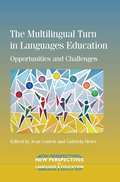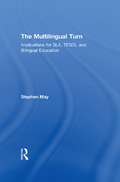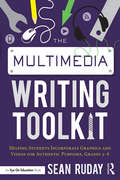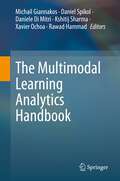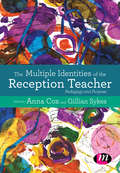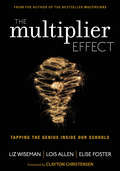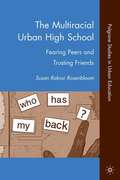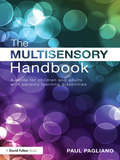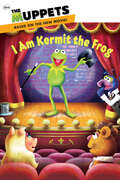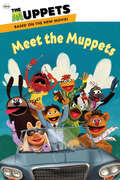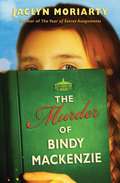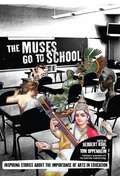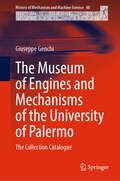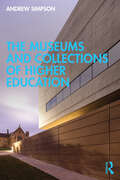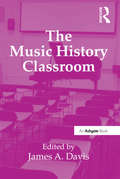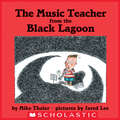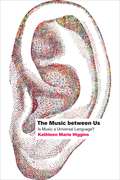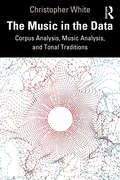- Table View
- List View
The Multilingual Turn in Languages Education
by Jean Conteh Gabriela MeierStarting from the key idea that learners and teachers bring diverse linguistic knowledge and resources to education, this book establishes and explores the concept of the 'multilingual turn' in languages education and the potential benefits for individuals and societies. It takes account of recent research, policy and practice in the fields of bilingual and multilingual education as well as foreign and second language education. The chapters integrate theory and practice, bringing together researchers and practitioners from five continents to illustrate the effects of the multilingual turn in society and evaluate the opportunities and challenges of implementing multilingual curricula and activities in a variety of classrooms. Based on the examples featured, the editors invite students, teachers, teacher educators and researchers to reflect on their own work and to evaluate the relevance and applicability of the multilingual turn in their own contexts.
The Multilingual Turn: Implications for SLA, TESOL, and Bilingual Education
by Stephen MayDrawing on the latest developments in bilingual and multilingual research, The Multilingual Turn offers a critique of, and alternative to, still-dominant monolingual theories, pedagogies and practices in SLA, TESOL, and bilingual education. Critics of the ‘monolingual bias’ argue that notions such as the idealized native speaker, and related concepts of interlanguage, language competence, and fossilization, have framed these fields inextricably in relation to monolingual speaker norms. In contrast, these critics advocate an approach that emphasizes the multiple competencies of bi/multilingual learners as the basis for successful language teaching and learning. This volume takes a big step forward in re-situating the issue of multilingualism more centrally in applied linguistics and, in so doing, making more permeable its key sub-disciplinary boundaries – particularly, those between SLA, TESOL, and bilingual education. It addresses this issue head on, bringing together key international scholars in SLA, TESOL, and bilingual education to explore from cutting-edge interdisciplinary perspectives what a more critical multilingual perspective might mean for theory, pedagogy, and practice in each of these fields.
The Multilingual and Intercultural Puppet: An Innovative Approach to Learning Foreign and Second Langauges
by Paula G. Eleta Mariano DolciAs the world becomes increasingly more interconnected and globalized, increasingly more families are seeking early (0-6 years) foreign and second language education, prompting educators and teachers to seek out age-appropriate tools which offer an innovative approach to early language learning (ELL). The Multilingual and Intercultural Puppet tries to answer two questions: How can we introduce children to foreign languages at an early age in a natural and also naturally playful way? And with which approach? This book presents a documented reflection that is rooted in concrete experiences which the authors have accumulated over the past twenty years of field-work, providing readers with many innovative yet practical and operational examples of how puppets have been used to facilitate ELL. Puppets, easily integrated into chilren’s natural play environment, represent a pedagogical tool par excellence for the teaching-learning of foreign languages. Using puppets, educators can create stimulating and enriching learning contexts, engaging children and moving them towards educational learning objectives, very naturally and through active and interactive play. Moreover, puppets, being puppets, can speak various languages, experience various life-events, and share these with young learners, be they homogeneous, heterogeneous, international, transcultural and/or intercultural groups. Indeed, “the language of puppets” is naturally multilingual and intercultural.
The Multimedia Writing Toolkit: Helping Students Incorporate Graphics and Videos for Authentic Purposes, Grades 3–8
by Sean RudayThe Multimedia Writing Toolkit demonstrates how, by drawing on students’ interest in and familiarity with technology, you can integrate multimedia to maximize the potential of writing instruction. In eight concise chapters, author Sean Ruday identifies and describes simple, common forms of multimedia that upper-elementary and middle school students can use to improve their argument, informational, and narrative writing and critical thinking. You’ll learn how to: Incorporate multimedia into argument, informational, and narrative writing through students’ use of video topic trailers, online discussion boards, webpages, and more. Evaluate students on effective use of multimedia through easy-to-follow rubrics and explicitly articulated learning goals. Understand more fully the key forms of multimedia through user-friendly overviews and explanations; you don’t need to be a "techie" teacher to use these strategies! Overcome possible obstacles to the integration of multimedia in the classroom by learning from the author’s concrete, first-hand examples and instructional recommendations. This book is complete with resources designed to provide you with extra support, including reproducible classroom-appropriate charts and forms, links to key web-based content discussed in the book, and a guide for teachers and administrators interested in using the book for group-based professional development. With The Multimedia Writing Toolkit, you’ll have a clear game plan for encouraging your students to become more engaged, technologically savvy learners. Bonus: Blank templates of the handouts are available as printable eResources on our website (www.routledge.com/9781138200111).
The Multimodal Learning Analytics Handbook
by Michail Giannakos Daniel Spikol Daniele Di Mitri Kshitij Sharma Xavier Ochoa Rawad HammadThis handbook is the first book ever covering the area of Multimodal Learning Analytics (MMLA). The field of MMLA is an emerging domain of Learning Analytics and plays an important role in expanding the Learning Analytics goal of understanding and improving learning in all the different environments where it occurs. The challenge for research and practice in this field is how to develop theories about the analysis of human behaviors during diverse learning processes and to create useful tools that could augment the capabilities of learners and instructors in a way that is ethical and sustainable. Behind this area, the CrossMMLA research community exchanges ideas on how we can analyze evidence from multimodal and multisystem data and how we can extract meaning from this increasingly fluid and complex data coming from different kinds of transformative learning situations and how to best feed back the results of these analyses to achieve positive transformative actions on those learning processes. This handbook also describes how MMLA uses the advances in machine learning and affordable sensor technologies to act as a virtual observer/analyst of learning activities. The book describes how this “virtual nature” allows MMLA to provide new insights into learning processes that happen across multiple contexts between stakeholders, devices and resources. Using such technologies in combination with machine learning, Learning Analytics researchers can now perform text, speech, handwriting, sketches, gesture, affective, or eye-gaze analysis, improve the accuracy of their predictions and learned models and provide automated feedback to enable learner self-reflection. However, with this increased complexity in data, new challenges also arise. Conducting the data gathering, pre-processing, analysis, annotation and sense-making, in a way that is meaningful for learning scientists and other stakeholders (e.g., students or teachers), still pose challenges in this emergent field. This handbook aims to serve as a unique resource for state of the art methods and processes. Chapter 11 of this book is available open access under a CC BY 4.0 license at link.springer.com.
The Multiple Identities of the Reception Teacher: Pedagogy and Purpose
by Gillian Sykes Anna CoxThe Reception Year is a special time for children and their teachers. This text celebrates the uniqueness of the Reception Year and the unique role of the Reception Teacher. This is a book for those aspiring to be reception teachers, those new to teaching in reception and for those with a love for the reception year. This text addresses many key features of working with 4 and 5 year olds in the reception class environment. These include: creating a positive learning environment that values every child involving parents and carers in children's learning understanding about child development to support your role spreading the word on the importance of early years teaching and learning discovering what works for you and your class creating effective learning spaces and resources harnessing the learning potential of the outdoor environment taking risks and challenging yourself and your class being the best teacher for your class this year and in the years to come Working in Reception you are not just a teacher. You will also be a carer, a collaborator in learning, a partner in play, a creator of magical environments, a leader of your team and an observer of the creativity and skills of young learners. This text will help you to understand your role and be the best Reception teacher you can be.
The Multiple Identities of the Reception Teacher: Pedagogy and Purpose
by Gillian Sykes Anna CoxThe Reception Year is a special time for children and their teachers. This text celebrates the uniqueness of the Reception Year and the unique role of the Reception Teacher. This is a book for those aspiring to be reception teachers, those new to teaching in reception and for those with a love for the reception year. This text addresses many key features of working with 4 and 5 year olds in the reception class environment. These include: creating a positive learning environment that values every child involving parents and carers in children′s learning understanding about child development to support your role spreading the word on the importance of early years teaching and learning discovering what works for you and your class creating effective learning spaces and resources harnessing the learning potential of the outdoor environment taking risks and challenging yourself and your class being the best teacher for your class this year and in the years to come Working in Reception you are not just a teacher. You will also be a carer, a collaborator in learning, a partner in play, a creator of magical environments, a leader of your team and an observer of the creativity and skills of young learners. This text will help you to understand your role and be the best Reception teacher you can be.
The Multiple Intelligences of Reading and Writing: Making the Words Come Alive
by Thomas ArmstrongShows how using Multiple Intelligences will help students acquire reading and writing skills.
The Multiple Menu Model: A Practical Guide for Developing Differentiated Curriculum
by Joseph RenzulliBased on constructivist learning theory, The Multiple Menu Model presents six practical menus that guide curriculum developers as they bring together an understanding of a discipline, its content and methodologies, and a vast array of instructional techniques. Teachers have successfully used this approach to challenge learners on all levels and make learning more meaningful, relevant, and engaging.The Knowledge Menu aids educators as they locate a topic in the realm of knowledge, uncover the basic principles and concepts, and explore the methodology used by practicing professionals in the field. The Instructional Objectives and Student Activities Menu helps teachers address issues of balance between content and process objectives as they write curriculum. The Instructional Strategies Menu reminds educators of the wide range of teaching strategies they can use within a lesson or unit. The Instructional Sequences Menu helps educators organize and sequence a unit or lesson to maximize impact and outcomes. The Artistic Modification Menu encourages teachers to inject the curriculum with their own creative contributions, such as personal stories, collected memorabilia, and hobby materials. The Instructional Product Menu presents the outcomes of learning experiences. Using the six menus, step-by-step planning guides, and reproducible templates, curriculum developers can:challenge all students with opportunities for higher level learning;place a premium on organization and pursuit of authentic knowledge;use real-world investigative skills in the classroom;blend advanced content and higher level thinking processes;teach enduring concepts and principles instead of trendy topics and transitory information;focus on representative topics that are used as a vehicle for process development;inject personal stories, experiences, and realia into lessons to heighten motivation and engage imagination;differentiate lessons to meet the needs of all students; andengage students in pursuing topics of their own personal interest and producing authentic products of their own choosing.Teachers using the Multiple Menu Model provide challenging curriculum opportunities for all students and guidance for exploring and applying knowledge in the real world.
The Multiplier Effect: Tapping the Genius Inside Our Schools
by Liz Wiseman Ms Lois N. Allen Elise FosterWhen you become a Multiplier, your whole team succeeds! Why do some leaders double their team’s effectiveness, while others seem to drain the energy right out of the room? Using insights gained from more than 100 interviews with school leaders, this book pinpoints the five disciplines that define how Multipliers bring out the best across their schools. By practicing these disciplines, you’ll learn how to: Attract top teachers to your school, Create an intense environment that demands people’s best thinking, Drive sound decisions by constructing debate and decision-making forums, Give your team a sense of ownership for responsibilities and results.
The Multiracial Urban High School
by Susan Rakosi RosenblooFrom 1996-2000, thirty minority teenagers (African American, Chinese American, Puerto Rican American, and Dominican American) were interviewed every year for four years to investigate how their experiences in high school shaped their social relationships.
The Multisensory Handbook: A guide for children and adults with sensory learning disabilities
by Paul PaglianoDo you support a child or adult with sensory perceptual issues or cognitive impairment? For people with challenging sensory and cognitive conditions, everyday life can become so unpredictable and chaotic that over time, lack of engagement can often lead to a state of learned helplessness. In this insightful text, Paul Pagliano shows how ‘learned helplessness’ can be transformed into learned optimism through multisensory stimulation, and explains how a programme of support can be designed and modulated to match the person’s needs, interests and abilities. Full of practical, easy to use multisensory assessment tools and intervention strategies, this book will help: foster a feeling of ease with the environment the child or adult experience pleasure and happiness kick-start their desire to explore encourage improved learning, social well-being and quality of life. The author offers an abundance of exciting multisensory stimulation ideas that can be applied to communication, play, leisure and recreation, therapy and education. Practical resources also show how to monitor and review applications to ensure they are being used in the most effective and enjoyable ways possible. Informed by an astute, up-to-date, comprehensive overview of research and theory, The Multisensory Handbook will appeal to primary professionals from a wide range of disciplines including education, health and social care.
The Multivoices of Kenyan Primary School Children Learning to Read and Write
by Esther Mukewa LisanzaThis book provides a rich and nuanced examination of children learning to read and write a second language in primary schools in Kenya, taught by teachers who themselves have often learned English as a second or third language. The author uses two case studies, of an urban and a rural school, to explore how different socioeconomic and cultural contexts can affect the enactment of language policies and their effect on literacy. This book contributes a unique perspective to studies in language and literacy education due to its distinctive exploration of young children learning to read and write in the English language in Kenya, and it will be of particular interest to students and scholars of applied linguistics, language education, bilingualism and language policy.
The Muppets: I Am Kermit the Frog
by Ray SantosA young green frog named Kermit loves singing and dancing and playing his banjo. He decides he wants to spend his life making people happy with his songs so he decides to head off to a place called Hollywood. Join in on the adventure and laugh along with Kermit and his new friends.
The Muppets: Meet the Muppets
by Ray SantosMeet all of the Muppets in this illustrated early reader, just in time for the brand new Muppets major motion picture!
The Murder Game
by Carrie DoyleA murder at a boarding school is gruesome enough, but what if the murderer is your roommate? Perfect for fans of A Study in Charlotte comes a gripping prep school novel filled with dark mystery and suspense.What if your best friend and roommate killed a teacher at your prep school? Or what if he didn't do it, but he's being framed, and you're the only person who can save him? What if you aren't sure which it is?Luke Chase didn't mean to get caught up solving the mystery of Mrs. Heckler's murder. He just wanted to meet up with the new British girl at their boarding school, and if that meant sneaking out to the woods after hours, then so be it.Little did he know someone would end up dead right next to their rendezvous spot, and his best friend and roommate Oscar Weymouth would go down for it. With suspects aplenty and a past that's anything but innocent, Luke Chase calls on his famous survival skills to solve the mystery and find the true killer."A taut, high-energy whodunit."—Booklist2018 Literary Classics Silver Award Winner for YA Mystery2018 Dane Rosetti YA Award Semi-Finalist
The Murder of Bindy Mackenzie
by Jaclyn MoriartyBindy Mackenzie is the most perfect girl at Ashbury High. She scores in the 99.9th percentile in all her classes. Clearly, Bindy has everything under control...Until her oh-so-perfect life starts falling oh-so-perfectly apart. She falls asleep in class. She fails an exam for the first time ever. And she can't stop thinking about handsome Finnegan Blonde. Is it a conspiracy? Madness? Or even murder? The clues are in Bindy's transcripts. The detectives are her fellow students. But Bindy has made every one of them into an enemy...and time is running out.
The Muses Go to School
by Herbert Kohl Tom OppenheimWhat do Whoopi Goldberg, Phillip Seymour Hoffman, Rosie Perez, and Phylicia Rashad have in common? A transformative encounter with the arts during their school years. Whether attending a play for the first time, playing in the school orchestra, painting a mural under the direction of an art teacher, or writing a poem, these famous performers each credit an experience with the arts at school with helping them discover their inner humanity and putting them on the road to fully realized creative lives.In The Muses Go to School, autobiographical pieces with well-known artists and performers are paired with interpretive essays by distinguished educators to produce a powerful case for positioning the arts at the center of primary and secondary school curriculums. Spanning a range of genres from acting and music to literary and visual arts, these smart and entertaining voices make surprising connections between the arts and the development of intellect, imagination, spirit, emotional intelligence, self-esteem, and self-discipline of young people.With support from a star-studded cast, editors Herbert Kohl and Tom Oppenheim present a memorable critique of the growing national trend to eliminate the arts in public education. Going well beyond the traditional rationales, The Muses Go to School shows that creative arts, as a means of academic and personal development, are a critical element of any education. It is essential reading for teachers, parents, and anyone who really cares about education.
The Museum of Engines and Mechanisms of the University of Palermo: The Collection Catalogue (History of Mechanism and Machine Science #48)
by Giuseppe GenchiThe book describes the collection of the Museum Engines and Mechanisms of the University of Palermo, Italy, one of the most important and heterogeneous collections of engines and mechanisms in Europe, the first one in Italy to be awarded as Mechanical Engineering Heritage Collection by the American Society of Mechanical Engineers. Thanks to its numerous items, this book showcases the evolution of fluid machinery and applied mechanics, from steam engines up to turbojet engines, as well as hybrid system, giving several technical and historical information about its most important engines, which are described in detail through pictures and original drawings. The Museum preserves and makes freely available this almost unique collection of more than 300 engines, didactic models, and technical equipment, including various unique exemplars, continuously enhanced thanks to donations and through restoration activities carried out in a dedicated laboratory of the Museum. As a result of a great deal of philological research carried out on the documents collected in the Museum’s archive, as well as in other institutional and corporate historical archives, this book serves as the reference tool of the collection and, more generally, of the Museum itself. Despite the technical subject and the academic environment in which it was created, the catalogue is realized to be read even by non-experts, offering different levels of detail, the first of which is the historical, economic and, in certain cases, even sporting context related to an engine, such as the vehicle for which it was designed and used.
The Museums and Collections of Higher Education
by Andrew SimpsonThe Museums and Collections of Higher Education provides an analysis of the historic connections between materiality and higher education, developed through diverse examples of global practice. Outlining the different value propositions that museums and collections bring to higher education, the historic link between objects, evidence and academic knowledge is examined with reference to the origin point of both types of organisation. Museums and collections bring institutional reflection, cross-disciplinary bridges, digital extension options and participatory potential. Given the two primary sources of text and object, a singular source type predisposes a knowledge system to epistemic stasis, whereas mixed sources develop the potential for epistemic disruption and possible change. Museums and collections, therefore, are essential in the academies of higher learning. With the many challenges confronting humanity, it is argued that connecting intellect with social action for societal change through university museums should be a contemporary manifestation of the social contract of universities. Much has been written about museums and universities, but there is little about university museums and collections. This book will interest museum scholars and practitioners especially those unaware that university museums are at the forefront of museological creativity. It will also be of interest to academics and the growing number of leaders and managers in the modern university.
The Music History Classroom
by James A. DavisThe Music History Classroom brings together essays written by recognized and experienced teachers to assist in the design, implementation, and revision of college-level music history courses. This includes the traditional music history survey for music majors, but the materials presented here are applicable to other music history courses for music majors and general education students alike, including period classes, composer or repertory courses, and special topics classes and seminars. The authors bring current thought on the scholarship of teaching and learning together with practical experience into the unique environment of the music history classroom. While many of the issues confronting teachers in other disciplines are pertinent to music history classes, this collection addresses the unique nature of musical materials and the challenges involved in negotiating between historical information, complex technical musical issues, and the aesthetics of performing and listening. This single volume provides a systematic outline of practical teaching advice on all facets of music history pedagogy, including course design, classroom technology, listening and writing assignments, and more. The Music History Classroom presents the 'nuts-and-bolts' of teaching music history suitable for graduate students, junior faculty, and seasoned teachers alike.
The Music Producer's Ultimate Guide to FL Studio 20: Create production-quality music with FL Studio
by Joshua Au-YeungLeverage the power of FL Studio 20 to create and compose production-quality songs and develop professional music production skillsKey FeaturesLeverage the power of FL Studio to create your own production-level musicDevelop widely applicable music production skills and learn how to promote your musicUtilize cutting-edge tools to fuel your creative ideas and publish your songsBook DescriptionFL Studio is a cutting-edge software music production environment and an extremely powerful and easy-to-use tool for creating music. This book will give you everything you need to produce music with FL Studio like a professional.You'll begin by exploring FL Studio 20's vast array of tools, and discover best practices, tips, and tricks for creating music. You'll then learn how to set up your studio environment, create a beat, compose a melody and chord progression, mix sounds with effects, and export songs. As you advance, you'll find out how to use tools such as the Piano roll, mixer console, audio envelopes, types of compression, equalizers, vocoders, vocal chops, and tools for increasing stereo width. The book introduces you to mixing best practices, and shows you how to master your songs. Along the way, you'll explore glitch effects and create your own instruments and custom-designed effect chains. You'll also cover ZGameEditor Visualizer, a tool used for creating reactive visuals for your songs. Finally, you'll learn how to register, sell, and promote your music.By the end of this FL Studio book, you'll be able to utilize cutting-edge tools to fuel your creative ideas, mix music effectively, and publish your songs.What you will learnGet up and running with FL Studio 20Record live instruments and vocals and process themCompose melodies and chord progressions on the Piano rollDiscover mixing techniques and apply effects to your tracksExplore best practices to produce music like a professionalPublish songs in online stores and promote your music effectivelyWho this book is forThis book is for music producers, composers, songwriters, DJs, and audio engineers interested in creating their own music, improving music production skills, mixing and mastering music, and selling songs online. To get started with this book, all you need is a computer and FL Studio.
The Music Teacher from the Black Lagoon (Black Lagoon Adventures)
by Mike ThalerIt's another scary day at the Black Lagoon. . . .Join Hubie once again as he faces his comically horrific fears during his first day of music class. Featuring a Valkyrie/Viking teacher who comes armed with a pitchfork, a laser baton, and a prison called Sing-Sing, this story is sure to amuse and quell fears of new experiences at the same time!
The Music between Us: Is Music a Universal Language?
by Higgins Kathleen MarieFrom our first social bonding as infants to the funeral rites that mark our passing, music plays an important role in our lives, bringing us closer to one another. In The Music between Us, philosopher Kathleen Marie Higgins investigates this role, examining the features of human perception that enable music's uncanny ability to provoke, despite its myriad forms across continents and throughout centuries, the sense of a shared human experience. Drawing on disciplines such as philosophy, psychology, musicology, linguistics, and anthropology, Higgins's richly researched study showcases the ways music is used in rituals, education, work, healing, and as a source of security and--perhaps most importantly--joy. By participating so integrally in such meaningful facets of society, Higgins argues, music situates itself as one of the most fundamental bridges between people, a truly cross-cultural form of communication that can create solidarity across political divides. Moving beyond the well-worn takes on music's universality, The Music between Us provides a new understanding of what it means to be musical and, in turn, human.
The Music in the Data: Corpus Analysis, Music Analysis, and Tonal Traditions
by Christopher WhitePutting forward an extensive new argument for a humanities-based approach to big-data analysis, The Music in the Data shows how large datasets of music, or music corpora, can be productively integrated with the qualitative questions at the heart of music research. The author argues that as well as providing objective evidence, music corpora can themselves be treated as texts to be subjectively read and creatively interpreted, allowing new levels of understanding and insight into music traditions. Each chapter in this book asks how we define a core music-theory topic, such as style, harmony, meter, function, and musical key, and then approaches the topic through considering trends within large musical datasets, applying a combination of quantitative analysis and qualitative interpretation. Throughout, several basic techniques of data analysis are introduced and explained, with supporting materials available online. Connecting the empirical information from corpus analysis with theories of musical and textual meaning, and showing how each approach can enrich the other, this book provides a vital perspective for scholars and students in music theory, musicology, and all areas of music research.
